Featured Application
Energy sector.
Abstract
Simulating complex systems in real time presents both significant advantages and challenges. Hardware-in-the-loop (HIL) simulation has emerged as an interesting technique for addressing these challenges. While HIL has gained attention in the scientific literature, its application in energy studies and power systems remains scattered and challenging to locate. This paper aims to provide an assessment of the penetration of the HIL technique in energy studies and power systems. The analysis of the literature reveals that HIL is predominantly employed in evaluating electrical systems (smart grids, microgrids, wind systems), with limited application in thermal energy systems (energy storage). Notably, the combination of electrical hardware-in-the-loop (EHIL) and thermal hardware-in-the-loop (THIL) techniques has found application in the assessment of vehicle thermal management systems and smart cities and, recently, has also been adopted in building systems. The findings highlight the potential for further exploration and expansion of the HIL technique in diverse energy domains, emphasizing the need for addressing challenges such as hardware–software compatibility, real-time data acquisition, and system complexity.
1. Introduction
Studying real-world phenomena can be difficult; therefore, researchers have developed many techniques to address this challenge. Those techniques can be experimental, analytical, or via simulation models. Experimental research can be expensive but also time-consuming and not always easy. Analytical models become very challenging when complex systems are addressed. Therefore, simulation models have become very popular between researchers, engineers, and other stakeholders. Recently, researchers have joined both experimental work and simulation models in their studies, using the so-called hardware-in-the-loop (HIL) technique.
Hardware-in-the-loop (HIL) simulation is a powerful technique used in engineering and by the research community to simulate complex systems in real time using hardware and software to verify and validate system designs [1,2,3]. HIL systems enable engineers to evaluate their designs before deployment and identify potential issues before they occur. The HIL technique is widely used in various fields, including automotive, aerospace, power systems, and robotics [3,4,5,6].
HIL systems consist of two main components: a real-time simulation platform and physical hardware that represents the system being assessed. The simulation platform generates inputs to the physical hardware and reads the outputs from it. The physical hardware responds to the inputs from the simulation platform and provides outputs that are fed back to the simulation platform (Figure 1). This closed-loop system allows testing the performance of the system being designed under various scenarios, including extreme and rare conditions that may be difficult or impossible to replicate in a real-world environment [2,4].
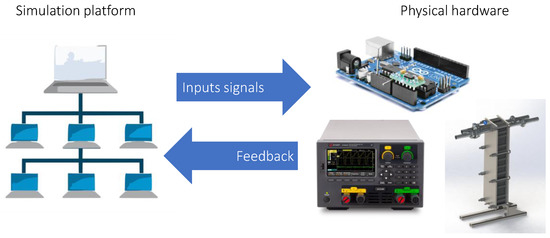
Figure 1.
Hardware in the loop operation concept.
The HIL technique has numerous advantages over traditional testing methods, such as analytical modelling and physical testing [2,3,7]. For example, HIL testing can save time and money by reducing the need for expensive prototypes and physical testing [2,8,9,10]. It also enables engineers to test their designs under a wide range of conditions that may not be possible to achieve in a physical environment, such as extreme temperatures or weather conditions. Moreover, HIL testing is highly accurate and repeatable, providing a source of reliable data to make informed decisions about the component under analysis [2,3].
HIL is implemented in a wide variety of sectors globally. For example, to meet sustainable development goals [11], cities are transitioning towards interconnected systems that provide essential services such as energy, transport, and water. These systems are becoming increasingly complex, with sophisticated control strategies and real-time data management. Hardware-in-the-loop (HIL) simulation offers a way to evaluate these systems in a controlled environment without the risk of disrupting city operations. In recent years, HIL simulation has gained attention as a tool for testing and optimizing smart city systems. HIL simulations are used in a variety of smart city applications, including transportation systems [12,13,14], energy management systems [15,16,17], lighting systems [18], 5G networks [13,19], and urban ecosystems [20,21].
In grid energy management systems, HIL simulation is used to evaluate the performance of microgrid systems. Testing the performance of a hybrid energy storage control strategy on an islanded microgrid system under different load conditions [15].
At the building level, HIL has gained attention as a tool for testing and optimizing buildings. Building systems, such as heating, ventilation, and air conditioning (HVAC), lighting, and energy management systems, are becoming increasingly complex as they incorporate more sophisticated control strategies and integrate with other building systems. HIL simulation offers a way to test these systems in a controlled environment without the risk of disrupting building operations [16,17,22,23].
Given the continuously growing body of information on the topic and the lack of concentrated and condensed information, it is not easy to identify in the scientific literature what are the global trends on HIL in the energy sector and what are the benefits and drawbacks of it. Therefore, this paper proposes to perform a bibliometric analysis of the topic. Bibliometric analysis is a powerful tool for mapping the research landscape and understanding the state of the art in a particular field of study. By analyzing publication and citation patterns, bibliometric analysis can provide a comprehensive overview of the research output, trends, and impact of a particular technology [24,25]. This information can help researchers and decision-makers identify key players and leading institutions in a field, pinpoint emerging areas of research, and track the evolution of a technology over time [26,27,28]. Furthermore, a bibliometric analysis can provide insights into the most influential publications, authors, and research collaborations, as well as identify gaps in knowledge and potential areas for future research. Overall, bibliometric analysis is a valuable tool for understanding the current state of a technology and can guide researchers and decision-makers in making informed decisions about resource allocation and research directions.
Therefore, the aim of this paper is to evaluate how HIL systems are studied and applied related to the energy sector around the world. Thus, it serves as a guideline to researchers and decision-makers in making informed decisions on resource allocation and research directions. The main research question is to assess whether there is penetration of this concept in research approaches in countries around the world.
2. Materials and Methods
The bibliometric analysis was conducted using the Scopus database. The Scopus database includes a higher number of documents about technological topics than other databases, such as the Web of Science database [29]. A search was conducted for the key terms “hardware in the loop” and “energy” but removed the keyword “synthetic aperture” from the title, abstract, and keywords fields. The exclusion will remove radar test studies performed using hardware in the loop. So, the resulting query was (TITLE-ABS-KEY(((“hardware in the loop” AND (energy)) ANDNOT “synthetic aperture”))). In the search results, 1919 documents appear, confirming the topic’s popularity among scientists. An analysis of bibliometric data was conducted using R-tool software (version 2023.03.0+386) with bibliometrix library [30] and VosViewer (version 1.6.16) [31] for the timespan 1992–2023. According to the database downloaded, these 1919 documents contain information from 781 sources, 4999 authors, 9837 KeyWords Plus, and 4510 authors’ keywords. Moreover, the annual growth rate (%) for the database is 14.79, and the average number of citations per document is 10.93.
3. Results
3.1. Bibliometric Analysis
Figure 2 shows the annual scientific production when HIL is used related to energy systems. The first documents already appeared in 1992, but until 2004 the annual number of publications was exceptionally low (between 1 and 7 documents per year). There was a steady growth from 2004 until 2014 when there was a drop until 2016, when the number of publications started to grow at a rate of 50 to 100 documents per year.
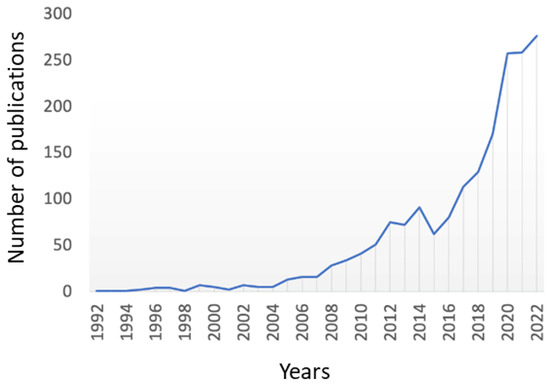
Figure 2.
Annual scientific production of HIL in energy systems. Data obtained from Scopus in April 2023. Query: (TITLE-ABS-KEY(((“hardware in the loop” AND (energy)) ANDNOT “synthetic aperture”))).
The first bibliometric analysis is the three-field plot, where the nine authors and the ten institutions with more publications are related to the nine keywords appearing in more documents (Figure 3). The authors, institutions, and keywords will be discussed in detail later on, but here it is interesting to highlight that while, as expected, the relation between author and institution with quite linear, the relation with the keywords is much more interlinked, showing that most authors/institutions work in several of the identified keywords.
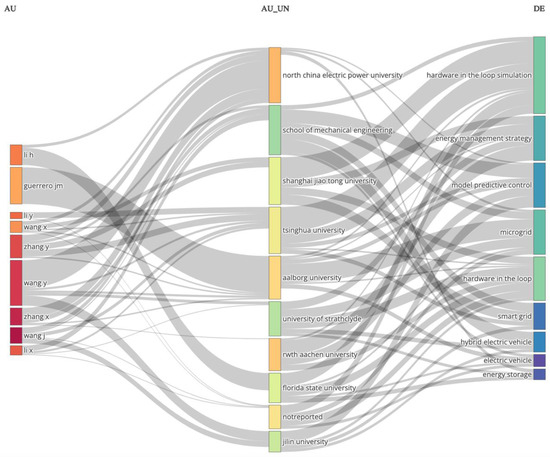
Figure 3.
Three-field plot using R-studio software and bibliometrix library, relating the 9 authors and the 10 institutions with more publications with the 9 keywords appearing in more documents. Data obtained from Scopus in April 2023. Query: (TITLE-ABS-KEY(((“hardware in the loop” AND (energy)) ANDNOT “synthetic aperture”))).
The sources most used to publish documents on HIL in energy systems (Figure 4) were Energies (with 64 documents), nearly doubling the rest of the sources, which were SAE Technical Papers (with 39 documents), IEEE Transactions on Industrial Electronics (with 39 documents), and Energy and IEEE Access (with 33 documents each). Of these ten sources, six of them are from IEEE (Institute of Electrical and Electronics Engineers), and two are from Elsevier.
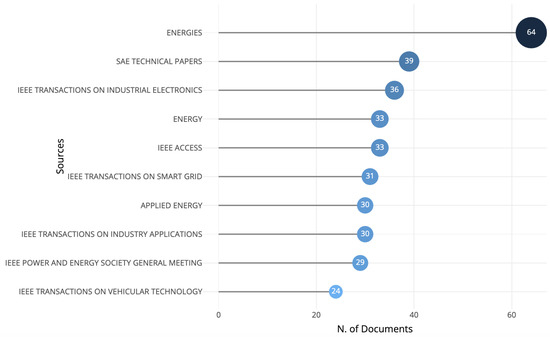
Figure 4.
Most relevant sources of HIL in energy systems using R-studio software and bibliometrix library. Data obtained from Scopus in April 2023. Query: (TITLE-ABS-KEY(((“hardware in the loop” AND (energy)) ANDNOT “synthetic aperture”))).
Figure 5a lists the authors with more documents retrieved with the query HIL in energy systems. The most prolific author had 40 documents, J. Wang (Jilin University), followed by X. Zhang (China Electric Power Research Institute—CEPRI, State Key Laboratory of Control and Operation of Renewable Energy and Storage Systems) with 38 documents, Y. Wang (Hebei University of Technology and China Automotive Technology and Research Center) with 34 documents, and Y. Zhang (Research and Development Center) with 30 documents. It should be highlighted that nine out of the ten authors for more documents are from China; the other author, J.M. Guerrero, is affiliated with the Center for Research on Microgrids (CROM) at Aalborg University in Denmark.
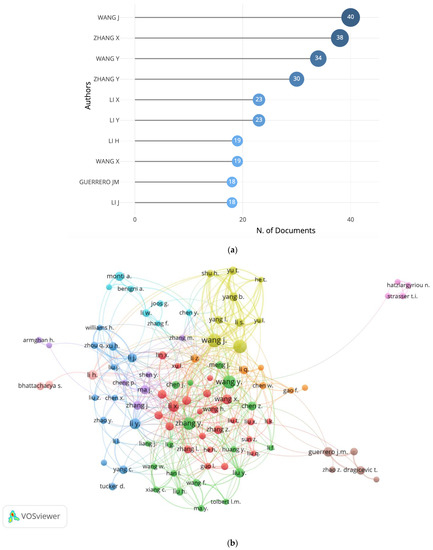
Figure 5.
Most relevant authors of HIL in energy systems. (a) Number of documents—using R-studio software and bibliometrix library—and (b) collaboration network—using VOSviewer. Data obtained from Scopus in April 2023. Query: (TITLE-ABS-KEY(((“hardware in the loop” AND (energy)) ANDNOT “synthetic aperture”))).
Figure 5b shows that most authors from China work together and in close collaboration using VosViewer software. For example, the two authors with more publications, J. Wang (Jilin University) and X. Zhang (China Electric Power Research Institute—CEPRI, State Key Laboratory of Control and Operation of Renewable Energy and Storage Systems), are together in the yellow cluster. Similarly, Y. Wang (Hebei University of Technology and China Automotive Technology and Research Center) and Y. Zhang (Research and Development Center) are in the same cluster (green cluster), showing their close collaboration. On the other hand, the authors from Europe, including J.M. Guerrero (Aalborg University), are in a cluster together (brown cluster) and at quite a long distance from the Chinese authors, although showing some collaborations.
Figure 6 shows that the institution with the highest number of documents is North China Electric Power University from China (with 105 documents). Then, a group of three institutions appears, Tsinghua University and Shanghai Jiao Tong University, both from China, and RWTH Aachen University from Germany (with 85, 80, and 73 documents, respectively). The fifth institution with the most publications on the topic studied is Jilin University, China (with 65 papers). The next five institutions with a higher number of documents on the topic studied (graph inside Figure 6) are the School of Mechanical Engineering, Beijing Institute of Technology, China (with 63 documents), Kunming University of Science and Technology, China (with 62 documents), Aalborg University, Denmark (with 58 documents), University of Strathclyde, UK (with 56 documents), and Florida State University (with 55 documents).
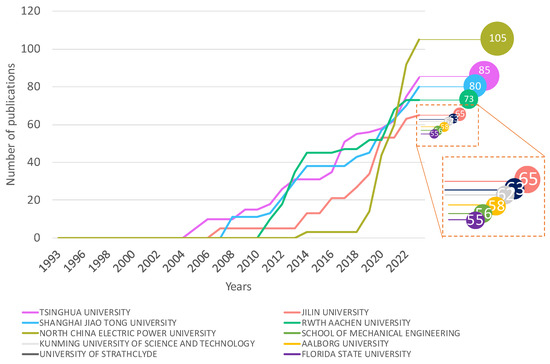
Figure 6.
Most relevant institutions of HIL in energy systems using R-studio software and bibliometrix library. Data obtained from Scopus in April 2023. Query: (TITLE-ABS-KEY(((“hardware in the loop” AND (energy)) ANDNOT “synthetic aperture”))).
It is interesting to evaluate not only how many documents each institution has produced but also when the research started in each one. Figure 6 shows that the institution with the first documents was Tsinghua University, and while its production is still within the top five, since 2012, Shanghai Jiao Tong University and RWTH Aachen University have published a remarkably similar number of documents on the topic of HIL in energy systems. It is interesting to see that North China Electric Power University only started to publish on the topic of HIL in energy systems in 2012, but in 2022, it published more documents than any other institution.
Figure 7 shows that the first documents appeared in the USA and, from 1992 until 2004, grew steadily in number of publications. France started to publish on the topic of study in 1998, and its growth has been steady since then, reaching 315 documents in 2022. Germany appeared in the figure in 2002, and while the growth was not explosive, it has been higher than in other countries, reaching 643 documents in 2022. The UK is the latest country that started to publish on the topic, having started in 2011, but in 2022, it reached 288 documents, nearly the same as France. Finally, China started to publish on the topic in 1999, but the number of publications per year has been increasing at a very high rate, with 501 documents already in 2017 and with 1982 documents in 2022.
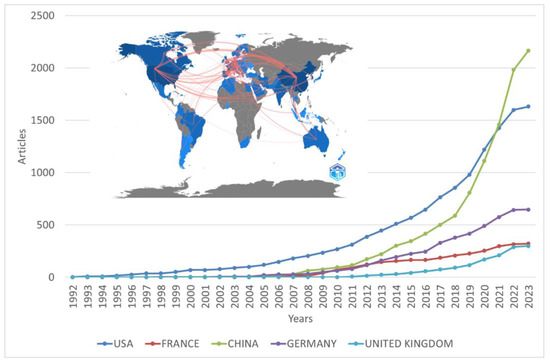
Figure 7.
Scientific production of HIL in energy systems by country using R-studio software and bibliometrix library. Countries with most scientific production and relation between countries. Data obtained from Scopus in April 2023. Query: (TITLE-ABS-KEY(((“hardware in the loop” AND (energy)) ANDNOT “synthetic aperture”))).
Moreover, Figure 7 shows that the biggest relations in publications about HIL in energy systems are between China and USA, the two countries with the highest number of documents. Relations between Europe and China are also strong, as well as between Europe and USA. Finally, the relationship between Australia with China, Europe, and USA (in this order) is more pronounced than with South America or Canada.
3.2. Keywords Analysis
Figure 8 presents the keywords found when applying HIL in energy systems as a query. The cloud representation (Figure 8a) shows that the keywords more used are “energy management” and “microgrid”, followed by “real-time simulation”, “model predictive control”, “energy management strategy”, and “hardware in the loop simulation”. The number of occurrences (Figure 8b) is 83 for “energy management” and 68 for “microgrid”. The other keywords with occurrences were “smart grid”, “energy storage”, “electric vehicle”, and “wind energy”. The other listed keywords had an occurrence between 51 (for “real-time simulation”) and 29 (for “wind energy”).
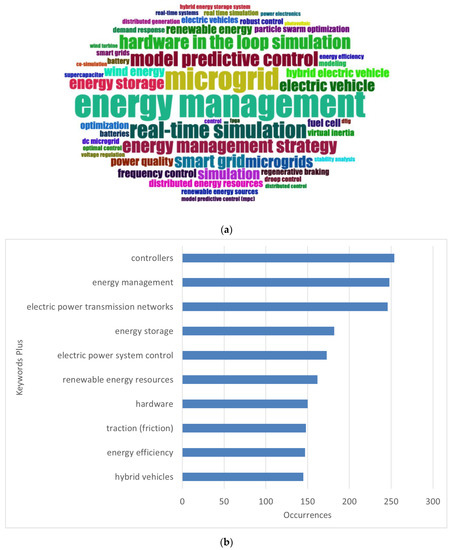
Figure 8.
Most frequent keywords of HIL in energy systems using R-studio software and bibliometrix library. (a) Cloud representation, and (b) number of occurrences. Data obtained from Scopus in April 2023. Query: (TITLE-ABS-KEY(((“hardware in the loop” AND (energy)) ANDNOT “synthetic aperture”))).
An interesting figure is Figure 9a, where the keywords more used are presented in frequency over time. Among the most recurrent keywords, the first one is “hybrid electric vehicles”, which appeared in 2006 and disappeared in 2016, with a maximum in 2010 and a term frequency of 6. “Energy conversion” appeared in 2010 but disappeared in 2012, being the keyword with the shortest duration but with the earliest appearance. Among the terms with more frequency, “hardware in the loop simulation” is the earliest one, lasting from 2012 to 2020, with a maximum in 2016 and a term frequency of 168. “Microgrid” and “energy management strategy” had their maximum frequency in 2020 and a term frequency of 131 and 126, respectively, starting only in 2018. Finally, the newest keywords are “cybersecurity” and “voltage control.

Figure 9.
(a) Trending topics and (b) thematic map of HIL in energy systems using R-studio software and bibliometrix library. Data obtained from Scopus in April 2023. Query: (TITLE-ABS-KEY(((“hardware in the loop” AND (energy)) ANDNOT “synthetic aperture”))).
The thematic map of the results of the query HIL in energy systems (Figure 9b) shows that the basic keywords are “energy management strategy”, “model predictive control”, and “hybrid electric vehicle”, while the motor keywords are “microgrid”, “smart grid”, and “energy storage”. All these keywords appeared after 2012 and are still used in recent publications (Figure 9a). It is interesting to see that there is only one niche keyword, “maximum power point tracking”. Finally, basic newer keywords are “hardware in the loop simulation” and “wind energy”, and emerging keywords are “distributed energy resources”, “particle swarm optimization”, and “power hardware in the loop”.
A factorial analysis of the keywords helps in understanding the main topics found in the research (Figure 10). There is a big cluster (red cluster) that includes most keywords related to the power system. For example, the terms “wind energy”, “power quality”, “smart grid”, and “distributed generation” are included here, but also terms related to control, such as “control” and “model predictive control”, and terms related to energy management and energy storage, such as “energy management strategy”, “demand response”, “electric vehicle”, and “energy storage system”, can be found. A second cluster (blue cluster) includes the keywords related to renewable energies, such as “renewable energy sources”, “distributed energy resources”, “microgrids”, and “voltage regulation”. The third cluster (purple cluster) is related to energy storage, with “hybrid energy storage system”, “battery”, “supercapacitor”, and “fuel cell”.
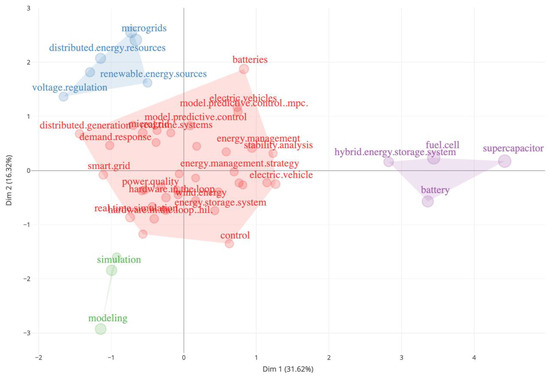
Figure 10.
Factorial analysis of HIL in energy systems using R-studio software and bibliometrix library. Data obtained from Scopus in April 2023. Query: (TITLE-ABS-KEY(((“hardware in the loop” AND (energy)) ANDNOT “synthetic aperture”))).
4. Discussion
Although the literature shows that in hardware in the loop applied to power systems, the systems can be divided into two specific topics, “electric hardware-in-the-loop” (EHIL) and “thermal hardware-in-the-loop” (THIL), this fact was not found in the bibliometric analysis, where most keywords were related to EHIL.
EHIL systems are used to assess electric power systems and components, such as generators, inverters, and motors [1,6,8,9,10]. These systems use real-time simulation and physical hardware to create a virtual environment for evaluating electrical components. EHIL systems are used in a variety of applications, including testing power systems for electric vehicles and renewable energy sources. For example, EHIL has been used to test battery management systems for electric vehicles to improve their performance and reliability [32]. In addition, EHIL has been used to test the impact of renewable energy sources, such as wind turbines and solar panels, on the power grid [32,33,34,35].
THIL systems, on the other hand, are implemented to evaluate thermal systems and components, such as heat exchangers, refrigeration systems, and air conditioning systems. THIL systems use real-time simulation and physical hardware to create a virtual environment for testing thermal systems. THIL is used in applications such as testing HVAC systems for buildings to improve their energy efficiency and reduce their environmental impact [36,37].
While EHIL and THIL are typically used separately to test electrical and thermal systems, there is an emerging trend to combine these two techniques to test systems that require both electrical and thermal performance verification. For example, EHIL and THIL were used together to assess electric vehicle thermal management systems [32]. In this application, EHIL was used to test the performance of the electric powertrain, while THIL was used to test the performance of the thermal management system.
Smart cities rely on interconnected systems to deliver essential services such as energy, transportation, and water. These systems are becoming increasingly complex, with sophisticated control strategies and real-time data management. Hardware-in-the-loop (HIL) simulation offers a way to test these systems in a controlled environment without the risk of disrupting city operations. In recent years, HIL simulation has gained attention as a tool for testing and optimizing smart city systems.
HIL simulation has been used in a variety of smart city applications, including transportation systems [12,13,14], energy management systems [15,16,17], lighting systems [18], 5G networks [13,19], and urban ecosystems [20,21].
In energy management systems, HIL simulation has been used to evaluate the performance of microgrid systems. For example, Haring et al. (2022) used HIL simulation to assess the performance of a hybrid energy storage control strategy on an islanded microgrid system under different load conditions. The results showed that the cyclic lifetime of the battery storage system could be increased with peak shaving due to a reduced amount of charging and discharging operations, and an excessive energy buffering control method could increase the islanded operation time by using nearly 10% of the otherwise lost energy [15].
In recent years, HIL simulation has gained attention as a tool for testing and optimizing buildings. Building systems, such as HVAC, lighting, and energy management systems, are becoming increasingly complex as they incorporate more sophisticated control strategies and integrate with other building systems. HIL simulation offers a way to assess these systems in a controlled environment without the risk of disrupting building operations [16,17,22,23].
HIL simulations were used in a variety of building systems applications, including HVAC, lighting, and energy management systems. One example of HIL simulation in HVAC systems is the distributed optimal HVAC systems adopting an edge computing strategy. The results showed that the IoT sensing network has the capacity to implement the distributed optimal control strategy and oversee the decomposed optimization tasks effectively [16].
5. Conclusions
Despite its many benefits, HIL simulation poses several challenges that must be addressed for it to be widely adopted in building systems applications. One challenge is hardware and software compatibility. HIL simulation requires specialized hardware and software, and integrating these components with existing building systems can be difficult. Another challenge is real-time data acquisition. HIL simulation requires real-time data to be acquired from the building systems being evaluated, and this data must be processed and fed back into the simulation in real time. This requires specialized data acquisition hardware and software that can operate in real time. Finally, system complexity is a major challenge associated with HIL simulation. Cities, buildings, and systems are becoming increasingly complex, and simulating these systems in real time requires significant computing power. This can be a limiting factor for smaller building systems applications where the ratio of added benefits vs. computer power and component costs may be too high.
Opportunities for Future Research
Despite these challenges, HIL simulation offers many opportunities for future research in cities, building, and systems. One area of future research is integrating HIL simulation with urban planning tools. Urban planning tools, such as geographic information systems (GIS), could be used to create more accurate and comprehensive simulations of smart city systems. Moreover, another interesting integration is HIL simulation with building information modelling (BIM). BIM is a digital representation of a building’s physical and functional characteristics, and integrating HIL simulation with BIM could enable more accurate and comprehensive testing of building systems.
Another area of future research is in the application of HIL simulation to emerging smart city technologies, such as autonomous vehicles and smart grids. HIL simulation could be used to optimize the performance of these technologies and identify opportunities for further innovation, and HIL could be applied to emerging building energy systems, such as integrated renewable energy systems. HIL simulation could be used to optimize the performance of these systems and identify opportunities for further energy savings.
Author Contributions
Conceptualization, L.F.C. and D.V.; methodology, M.T.; software, M.T.; validation, D.V.; formal analysis, L.F.C.; investigation, M.T. and D.V.; resources, L.F.C.; data curation, L.F.C.; writing—original draft preparation, D.V. and M.T.; writing—review and editing, L.F.C.; visualization, D.V. and M.T.; supervision, L.F.C.; project administration, L.F.C.; funding acquisition, L.F.C. All authors have read and agreed to the published version of the manuscript.
Funding
This work was partially funded by the Ministerio de Ciencia e Innovación—Agencia Estatal de Investigación (PID2021-123511OB-C31—MCIN/AEI/10.13039/501100011033/FEDER, EU and RED2022-134219-T).
Institutional Review Board Statement
Not applicable.
Informed Consent Statement
Not applicable.
Data Availability Statement
Data are available upon request to the corresponding author.
Acknowledgments
The authors thank the Generalitat de Catalunya for the quality accreditation granted to the GREiA research group (2021 SGR 01615) and the GRIHO research group (2021 SGR 01620). GREiA is a TECNIO-certified agent in the category of technological development of the Gobierno de Cataluña. This work is partially supported by ICREA inside the program ICREA Academia.
Conflicts of Interest
The authors declare no conflict of interest.
References
- Pimentel, J. Tutorial on Advances in Real-Time Hardware-in-the-Loop (HIL) Simulation Technologies. In Proceedings of the Huntsville Simulation Conference-HSC2009, Huntsville, AL, USA, 26–28 October 2009. [Google Scholar]
- Ceccolini, C.; Sangi, R. Benchmarking Approaches for Assessing the Performance of Building Control Strategies: A Review. Energies 2022, 15, 1270. [Google Scholar] [CrossRef]
- Mihalič, F.; Truntič, M.; Hren, A. Hardware-in-the-Loop Simulations: A Historical Overview of Engineering Challenges. Electronics 2022, 11, 2462. [Google Scholar] [CrossRef]
- Ellis, G. Chapter 1-Introduction to Controls. In Control System Design Guide, 4th ed.; Ellis, G., Ed.; Butterworth-Heinemann: Boston, MA, USA, 2012; pp. 3–7. [Google Scholar] [CrossRef]
- Palacio-Betancur, A.; Soto, M.G. Recent Advances in Computational Methodologies for Real-Time Hybrid Simulation of Engineering Structures. Arch. Comput. Methods Eng. 2022, 30, 1637–1662. [Google Scholar] [CrossRef]
- Palladino, A.; Fiengo, G.; Lanzo, D. A portable hardware-in-the-loop (HIL) device for automotive diagnostic control systems. ISA Trans. 2012, 51, 229–236. [Google Scholar] [CrossRef] [PubMed]
- Stoeppler, G.; Menzel, T.; Douglas, S. Hardware-in-the-loop simulation of machine tools and manufacturing systems. Comput. Control. Eng. J. 2005, 16, 10–15. [Google Scholar] [CrossRef]
- Archetti, J.A.G.; de Oliveira, L.W.; de Oliveira, J.G. Hardware-in-the-Loop Volt–Watt and Volt–VAr Control for Distribution Systems with High Penetration of Renewables. J. Control Autom. Electr. Syst. 2023, 34, 177–188. [Google Scholar] [CrossRef]
- Lamo, P.; de Castro, A.; Sanchez, A.; Ruiz, G.A.; Azcondo, F.J.; Pigazo, A. Hardware-in-the-Loop and Digital Control Techniques Applied to Single-Phase PFC Converters. Electronics 2021, 10, 1563. [Google Scholar] [CrossRef]
- Li, F.; Wang, Y.; Wu, F.; Huang, Y.; Liu, Y.; Zhang, X.; Ma, M. Review of Real-time Simulation of Power Electronics. J. Mod. Power Syst. Clean Energy 2020, 8, 796–808. [Google Scholar] [CrossRef]
- United Nations. The Sustainable Development Goals Report; United Nations: New York, NY, USA, 2020. [Google Scholar]
- Wang, F.-X.; Peng, Q.; Zang, X.-L.; Xue, Q.-F. Adaptive Cruise Control for Intelligent City Bus Based on Vehicle Mass and Road Slope Estimation. Appl. Sci. 2021, 11, 12137. [Google Scholar] [CrossRef]
- Jiang, J.; Yang, Y.; Li, Y.; Wang, R.; Zeng, S. Lane-Level Vehicle Counting Based on V2X and Centimeter-level Positioning at Urban Intersections. Int. J. Intell. Transp. Syst. Res. 2022, 20, 11–28. [Google Scholar] [CrossRef]
- Li, X.; Doss, A.C.A.; Guvenc, B.A.; Guvenc, L. Pre-Deployment Testing of Low Speed, Urban Road Autonomous Driving in a Simulated Environment. arXiv 2020, arXiv:2306.01185. [Google Scholar] [CrossRef]
- Haring, T.; Link, L.; Rosin, A.; Biechl, H. Hybrid Energy Storage Lifetime-Oriented Control Strategy in Islanded Microgrids: A Real Time Simulation Case Study; Institute of Electrical and Electronics Engineers Inc.: Piscataway, NJ, USA, 2022. [Google Scholar] [CrossRef]
- Su, B.; Li, X.; Wang, S.; Cao, J. Distributed Optimal Control for HVAC Systems Adopting Edge Computing—Strategy, Implementation, and Experimental Validation. IEEE Internet Things J. 2022, 9, 11858–11867. [Google Scholar] [CrossRef]
- Kharbouch, A.; Berouine, A.; Elkhoukhi, H.; Berrabah, S.; Bakhouya, M.; El Ouadghiri, D.; Gaber, J. Internet-of-Things Based Hardware-in-the-Loop Framework for Model-Predictive-Control of Smart Building Ventilation. Sensors 2022, 22, 7978. [Google Scholar] [CrossRef]
- Bruno, S.; Giannoccaro, G.; Iurlaro, C.; La Scala, M.; Rodio, C.; Sbrizzai, R. Fast Frequency Regulation Support by LED Street Lighting Control; Leonowicz, Z.M., Ed.; Institute of Electrical and Electronics Engineers Inc.: Piscataway, NJ, USA, 2021. [Google Scholar] [CrossRef]
- Cinque, E.; Valentini, F.; Smarra, F.; Franchi, F.; D’Innocenzo, A.; Pratesi, M. A Hardware-in-the-Loop Framework for Urban Mobility Scenarios within the 5G Trial in L’Aquila; Institute of Electrical and Electronics Engineers Inc.: Piscataway, NJ, USA, 2020. [Google Scholar] [CrossRef]
- Sędzicki, D.; Cudzik, J.; Nyka, L. Computer-Aided Greenery Design—Prototype Green Structure Improving Human Health in Urban Ecosystem. Int. J. Environ. Res. Public Health 2023, 20, 1198. [Google Scholar] [CrossRef]
- Babunski, D.; Zaev, E.; Poposki, F.; Koleva, R.; Rath, G. Development and Hardware-in-the-Loop Simulation of an Air Purifier Automatic Control System; Institute of Electrical and Electronics Engineers Inc.: Piscataway, NJ, USA, 2021. [Google Scholar] [CrossRef]
- Beregi, S.; Barton, D.A.W.; Rezgui, D.; Neild, S.A. Control-Free Dynamic Substructuring of a Three-Storey Building; Allen, M., D’Ambrogio, W., Roettgen, D., Eds.; Springer: Berlin/Heidelberg, Germany, 2023; pp. 59–61. [Google Scholar] [CrossRef]
- Zhang, Y.; Wulff, W.; Wernicke, L.; Engelmann, M.; Schauer, T.; Bleicher, A. Experimental identification and verification of a moveable facade element for energy harvesting and vibration control. J. Build. Eng. 2023, 65, 105712. [Google Scholar] [CrossRef]
- Bornmann, L.; Leydesdorff, L. Scientometrics in a changing research landscape: Bibliometrics has become an integral part of research quality evaluation and has been changing the practice of research. EMBO Rep. 2014, 15, 1228–1232. [Google Scholar] [CrossRef]
- Milfont, T.L.; Amirbagheri, K.; Hermanns, E.; Merigó, J.M. Celebrating Half a Century of Environment and Behavior: A Bibliometric Review. Environ. Behav. 2019, 51, 469–501. [Google Scholar] [CrossRef]
- Cabeza, L.F.; Frazzica, A.; Chàfer, M.; Vérez, D.; Palomba, V. Research trends and perspectives of thermal management of electric batteries: Bibliometric analysis. J. Energy Storage 2020, 32, 101976. [Google Scholar] [CrossRef]
- Calderón, A.; Barreneche, C.; Hernández-Valle, K.; Galindo, E.; Segarra, M.; Fernández, A.I. Where is Thermal Energy Storage (TES) research going?–A bibliometric analysis. Sol. Energy 2020, 200, 37–50. [Google Scholar] [CrossRef]
- Camarasa, C.; Nägeli, C.; Ostermeyer, Y.; Klippel, M.; Botzler, S. Diffusion of energy efficiency technologies in European residential buildings: A bibliometric analysis. Energy Build. 2019, 202, 109339. [Google Scholar] [CrossRef]
- Cabeza, L.F.; Chàfer, M.; Mata, É. Comparative Analysis of Web of Science and Scopus on the Energy Efficiency and Climate Impact of Buildings. Energies 2020, 13, 409. [Google Scholar] [CrossRef]
- Aria, M.; Cuccurullo, C. bibliometrix: An R-tool for comprehensive science mapping analysis. J. Informetr. 2017, 11, 959–975. [Google Scholar] [CrossRef]
- Van Eck, N.J.; Waltman, L. Software survey: VOSviewer, a computer program for bibliometric mapping. Scientometrics 2010, 84, 523–538. [Google Scholar] [CrossRef]
- Morello, R.; Di Rienzo, R.; Roncella, R.; Saletti, R.; Baronti, F. Hardware-in-the-Loop Platform for Assessing Battery State Estimators in Electric Vehicles. IEEE Access 2018, 6, 68210–68220. [Google Scholar] [CrossRef]
- Akhbari, A.; Rahimi, M.; Khooban, M.H. Various Control Strategies Performance Assessment of the DFIG wind turbine connected to a DC grid. IET Electr. Power Appl. 2023, 17, 687–708. [Google Scholar] [CrossRef]
- Rached, B.; Elharoussi, M.; Abdelmounim, E.; Bensaid, M. Design and DSP implementation in HIL of nonlinear observers for a doubly fed induction aero-generator. Bull. Electr. Eng. Inform. 2023, 12, 1340–1351. [Google Scholar] [CrossRef]
- Yousefzadeh, M.; Kia, S.H.; Marzebali, M.H.; Khaburi, D.A.; Razik, H. Power-Hardware-in-the-Loop for Stator Windings Asymmetry Fault Analysis in Direct-Drive PMSG-Based Wind Turbines. Energies 2022, 15, 6896. [Google Scholar] [CrossRef]
- Ho, C.N.M.; Fang, Y.; Xu, Y.; Jayawardana, I. Thermal-HIL Real-Time Testing Platform for Evaluating Cooling Systems of Power Rectifiers; Institute of Electrical and Electronics Engineers Inc.: Piscataway, NJ, USA, 2021; pp. 5729–5734. [Google Scholar] [CrossRef]
- Dehghan, S.; Viola, J.; Chen, Y. Preview Control Based on RIOTS MPC and H∞ for A Thermal Hardware in the Loop System. IFAC-Pap. Online 2021, 54, 729–734. [Google Scholar] [CrossRef]
Disclaimer/Publisher’s Note: The statements, opinions and data contained in all publications are solely those of the individual author(s) and contributor(s) and not of MDPI and/or the editor(s). MDPI and/or the editor(s) disclaim responsibility for any injury to people or property resulting from any ideas, methods, instructions or products referred to in the content. |
© 2023 by the authors. Licensee MDPI, Basel, Switzerland. This article is an open access article distributed under the terms and conditions of the Creative Commons Attribution (CC BY) license (https://creativecommons.org/licenses/by/4.0/).